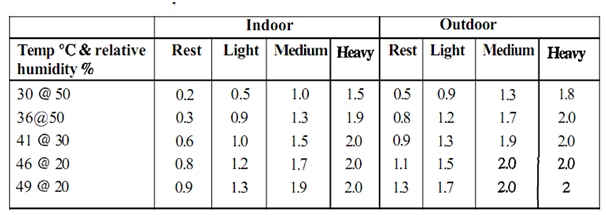Determine Nutritional Requirements in Hot Environments?
Hot environments may be of two types: dry hot, as in the case of deserts or hot and humid in tropical rain forests and coastal regions. Factors other than air temperature determine physiological strain imposed by the heat stress. These factors include individual variations in body size and fatness, acclimatization, and external factors such as air currents, heat gain due to radiation, intensity of work, clothing and relative humidity. Various practical heat stress indices (e ,g. wet bulb-globe temperature, Heat Stress Index) make use of# ambient temperature, radiant heat and relative humidity to evaluate the environmental potential heat challenge for humans working under that environment. Refer to Table 18.8, which highlights the effects of heat stress.

However, it is important to know that an adequate fluid replacement overshadows all other considerations of nutrient requirements for work in a hot environment. Drinking adequate amount of water at regular intervals prevents dehydration, heat, illness and maintains work performance. Heat acclimatization relatively has no effect on water requirements. Thirst is a poor indicator of hydration status: Intense thirst is usually noticed at 5 to 6% body weight loss due to hypohydration (removal of water). By this time, the physical performance is compromised. Severe hypohydration can-lead to a decreased blood volume and an increase in the plasma osmolality, which can result in decreased sweating and heat dissipation.
Eighty percent of the energy metabolized during exercise in hot environment is liberated as heat (only 20% is utilized as mechanical work) and 80-90% of heat dissipation during work in a hot-dry environment is accomplished by the evaporation of sweat. Each millilitre of sweat evaporated from the skin leads to heat loss of approximately 0.6 Kcal. Sweat rates vary to a great extent from at1 individual to individual, but can reach 2 L/h for prolonged time periods. Hypohydration depends in a large part upon sweat rate, which, in turn, is determined by workload and duration. Other environmental factors are solar load, wind speed, relative humidity and clothing, The influence of these factors on water requirement is given in above Table.